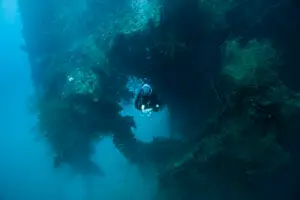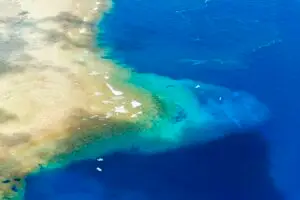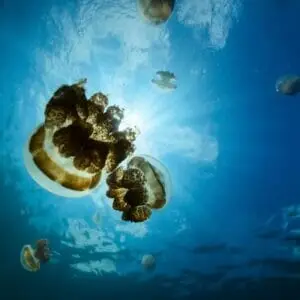If you’ve ever dreamed of floating effortlessly in warm tropical currents while a parade of sharks, barracuda, and swirling reef fish unfolds in front of you—without having to swim or kick to keep up—you’re going to love reef hook diving.
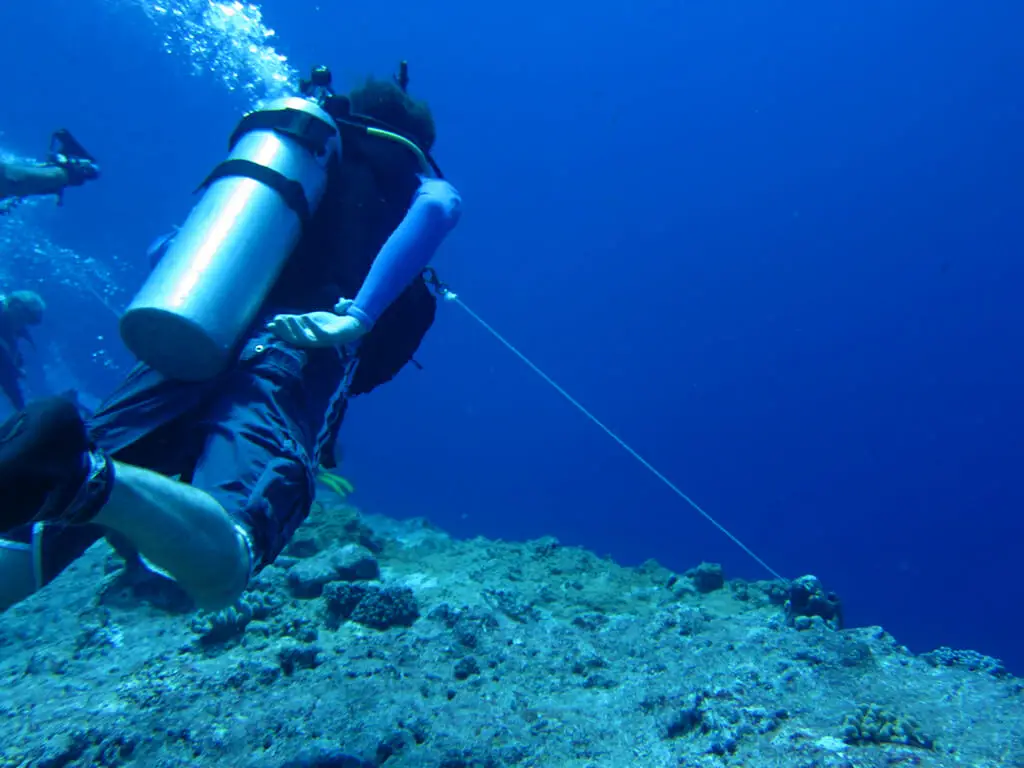
Invented right here in Palau, reef hook diving is a technique that lets you anchor yourself to a patch of rock or dead coral using a small stainless steel hook and line.
It’s the ultimate front-row seat to one of nature’s most spectacular shows: the nutrient-rich currents of Palau that attract some of the most exciting marine life on Earth.
Whether you’re preparing for your very first dive in Palau or looking to refine your technique for high-current sites like Blue Corner or Peleliu Corner, this guide covers everything you need to know.
You’ll learn what a reef hook is, how to use it, what gear to bring, and how to dive safely and responsibly.
Want to get inspired first? Take a closer look at the legendary Blue Corner dive site—the birthplace of reef hook diving and still one of the best places in the world to try it.
Let’s dive in.
Table of Contents
Who Should Try Reef Hook Diving?
Reef hook diving might sound like an advanced technique—and in some ways, it is—but it’s surprisingly accessible to many recreational divers with the right mindset and support. In fact, some divers try it for the first time in Palau and fall in love with it instantly.
If you’re already comfortable diving in moderate currents and can maintain neutral buoyancy without effort, you’re likely ready to give it a try.
You don’t need to be a technical diver or have hundreds of dives under your belt—but you should be confident underwater, able to stay calm in changing conditions, and follow your guide’s instructions closely.
What Skills Should You Have?
- Good buoyancy control (hovering comfortably without touching the reef)
- Experience in drift diving or diving with current
- Situational awareness (e.g., watching air, depth, buddy position)
- Familiarity with gear setup, especially BCD D-rings and clips
Even if you’ve never used a reef hook before, many Palauan guides will walk you through it—and even help set your hook on your first attempt if needed.
Who It’s Great For:
- Advanced Open Water divers or those with similar experience
- Underwater photographers who want a steady platform for capturing shark or pelagic action
- Marine life lovers who prefer watching behavior rather than chasing fish
- Adrenaline seekers who want to feel the rush of current—safely
Who Might Want to Wait:
- Brand-new divers with fewer than 10–15 dives
- Anyone who gets anxious in strong water movement
- Divers who still working on buoyancy or air consumption
Nervous? That’s Okay—Start Small
Many divers feel a little intimidated the first time they hear the word “hook.” But reef hook diving isn’t aggressive or extreme—it’s a resting technique. If you’re unsure, let your guide know.
They’ll likely bring you to a more beginner-friendly site like Ulong Channel, where you can hook in briefly, watch the sharks cruise by, and then drift calmly through the channel’s soft coral gardens.
Even better? You’ll never be alone. Guides in Palau are some of the most experienced reef hook instructors in the world, and they’ll be right beside you to help with gear, positioning, and timing.
Curious what reef hook diving looks like in action? Blue Corner is the iconic site where it all began—and where many first-timers become lifelong fans.
What Is Reef Hook Diving and Why Use It?
Reef hook diving is a technique used by divers to stay stationary in a strong current by anchoring themselves to a solid part of the reef—typically bare rock or dead coral—using a small stainless steel hook attached to a line and clipped to their BCD (buoyancy compensator device).
Rather than drifting along with the current, reef hook divers secure themselves in place and watch the marine world go by.
The concept was born in Palau, where dive sites like Blue Corner and Peleliu Corner often feature currents too strong for divers to swim against for long.
Local guides needed a safe and reef-friendly way to keep divers in one spot to observe the thrilling action happening where those currents hit the reef edge—and so, the reef hook was invented.
How Does It Work?
Imagine being a kite in the sky—only you’re underwater. You find a good hook point (always a rock or dead coral), secure the hook, and then let the current lift your body slightly into the water column.
The line keeps you from being swept away, and you hover effortlessly in place while schools of fish, sharks, and other pelagics pass by in front of you. It’s a front-row seat to the action, with zero kicking or chasing required.
Why Use a Reef Hook?
- To Save Energy and Air
In a strong current, it takes a lot of effort—and air—to stay in place without assistance. Reef hooking allows you to relax, conserve your air supply, and significantly extend your bottom time, especially during high-adrenaline moments. - To Protect the Reef
Without a hook, divers often grab rocks or corals to steady themselves, accidentally damaging fragile marine life. A properly used reef hook minimizes contact with the reef. In Palau, where conservation is a priority, this technique is part of the local dive culture for exactly that reason. - To Get Better Marine Life Encounters
Reef hook diving creates less disturbance. By staying still, you’re less threatening to animals, and they’ll often come closer. Divers regularly report sharks gliding just feet away, curious jacks circling, and turtles swimming by without a care. Your stillness allows for a more natural and respectful wildlife interaction. - To Capture Better Photos and Video
Photographers especially love reef hook dives. With both hands free and a steady position in the current, it’s much easier to frame and shoot fast-moving subjects. Just make sure your camera is well-secured—the current can rip gear away if it’s not attached. - To Access High-Energy Sites Safely
Many of Palau’s best dive sites—like New Drop-Off, Ulong Channel, and Siaes Corner—are known for fast-flowing water.
Reef hooks enable divers to explore these sites safely, without the risk of being swept away or overexerting themselves. It’s the key to unlocking some of the most spectacular diving in Micronesia.
How to Use a Reef Hook (Step-by-Step)
Reef hook diving isn’t complicated—but using the hook properly takes a bit of know-how, timing, and awareness. When done right, the whole experience feels effortless, safe, and even meditative. Below is a detailed walkthrough of how to execute a reef hook dive from start to finish.
Before You Enter the Water
- Attach your hook line to a strong D-ring on your BCD—preferably one located near your waist or hip for balance.
- Pre-fold or daisy chain your line to keep it tidy and tangle-free. Don’t let it dangle loose during descent.
- Double-check your gear: secure your console, octopus, and camera gear. Anything loose can snag or be lost in the current.
Step-by-Step Guide
- Follow Your Guide to the Staging Area
Your guide will typically lead the group to a calm pocket just below or behind the reef edge, away from the strongest flow. This is where you’ll prepare to hook in. - Approach Your Hook-In Spot
Stay low and slightly negative behind the reef ledge. Let the reef block the current while you search for a secure place to hook, ideally a bare rock or patch of dead coral. Never hook into live coral or soft substrate. - Deploy the Hook
Take out your reef hook with one hand. Firmly place the hook into a crevice or solid rock ledge. Test it gently to ensure it won’t shift under tension. Clip the other end of the line to your BCD if not already clipped in advance. - Add Some Air to your BCD and Hover
Add a touch of air to your BCD to become slightly buoyant. The current will catch your body, lifting you gently above the reef. Ideally, you’re hovering 1–2 meters above the substrate—high enough to avoid kicking anything, low enough to feel stable. - Enjoy the Show
Keep your fins up, body horizontal, and breathe calmly. Watch sharks cruise the blue, schools of jacks swirl around you, and turtles drift by. This is the magic of reef hook diving: zero effort, maximum reward.
- Prepare to Unhook
When your guide signals it’s time to move on—or you’re ready to drift—dump the air from your BCD to become negative again. Pull yourself gently toward the reef to reduce drag and unclip smoothly. - Unhook and Stow
- Unhook gently—never yank. If stuck, reposition instead of forcing it.
- Stow your hook in its pouch or clip it securely to avoid snagging.
- Keep one hand on your reg and mask as you detach—currents can be surprisingly strong.
- Drift or Ascend
Once free, let the current carry you along the reef or into the blue. If you’re ending the dive, ascend slowly and deploy your surface marker buoy (SMB) to signal your position to the boat crew.
Additional Tips
- Always unhook before inflating—never launch upward while still clipped in.
- Stay in sync with your buddy: hook in and unhook together to avoid separation.
- Practice deploying the hook line on land or in calm water first—it builds muscle memory.
Infographic: How to Use a Reef Hook Safely and Responsibly
Sometimes, it’s easier to learn by seeing—and this visual guide makes reef hook diving simple to understand, even if you’ve never done it before. Below, we’ve broken down the key steps, safety tips, and conservation-friendly techniques every diver should know before clipping in.
This infographic explains:
- Why reef hook diving helps you conserve air and stay relaxed
- How to attach and position your reef hook correctly
- What to avoid (like hooking into live coral)
- How to stay off the reef and protect marine life
- Why it’s great for photos—and fun with your dive group!
Tip: If you’re prepping for your first reef hook dive, save this image or bookmark it before your trip. It’s a great visual refresher before hitting the water.
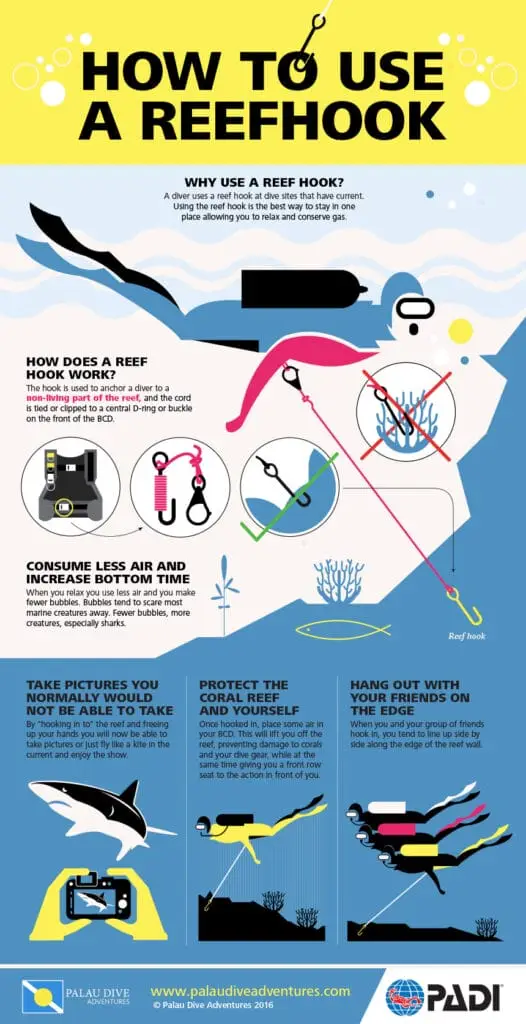
Essential Gear for Reef Hook Diving
Aside from your standard scuba kit, reef hook diving requires a few specialized items to ensure safety, comfort, and control in strong currents. In Palau, many dive shops provide reef hooks to guests, but it’s worth understanding what makes a good setup, especially if you bring your own or plan to rent.
Reef Hook and Line
The centerpiece of the setup is, of course, the reef hook. Most are made of curved stainless steel (4–6 inches long) connected to a 6–7 foot (2–2.5 meter) line. The other end has a clip or carabiner to attach to your BCD.
- Single-prong hooks are most common and ideal for Palau’s limestone ledges.
- Double-prong hooks offer extra grip in extreme current, but are less common.
- DIY or pre-shortened tethers are great for smaller divers or photographers—less slack means more control.
💡 Tip: Some models come with built-in pouches or retractors. If yours doesn’t, carry a small pouch to prevent it from dangling during the dive.
Proper Attachment Point
Where you clip your hook line on your BCD matters more than you might think. Most divers use a waist-level D-ring (on the front or hip), which keeps the pull low and your body stable. Avoid shoulder D-rings—clipping too high can flip you forward in the current, making it harder to see and control your position.
Gloves—Or Not
Palau prohibits diving gloves to discourage reef contact. Even though gloves can protect your hands during hook-in or unhooking, divers are expected to use bare hands and place hooks gently, avoiding any need to grab the reef. It’s part of Palau’s conservation ethos and is enforced on all dive operations.
In other destinations, lightweight gloves (e.g., Kevlar or textile) may be allowed, but always check local rules. For Palau: no gloves, no exceptions.
Surface Marker Buoy (SMB)
Every diver doing reef hook or drift dives should carry a bright, deployable SMB (a.k.a. safety sausage). This ensures you can be spotted by the boat in case you’re separated from the group or surface far from the reef. In Palau, SMBs are mandatory on many sites.
Line Cutter or Dive Knife
It’s rare, but in the event your hook gets badly stuck or entangled with old fishing line or coral, a compact line cutter or blunt-tip dive knife is essential. Clip it somewhere easily accessible—like your chest strap or thigh pocket.
Streamlined Dive Kit
Reef hook diving is all about reducing drag. You’ll be pulled by the current, so you want nothing flapping or dangling.
- Clip off your octopus, SPG, and accessories
- Tuck away console hoses
- Secure cameras and use leashes
Large camera rigs can catch the current easily. Photographers should consider shorter strobe arms and always use a lanyard for safety.
Exposure Protection
Even in tropical waters like Palau’s, wearing a full wetsuit or skinsuit helps protect against plankton stings, minor scrapes, and sun exposure while you hover shallow in the current. A 3mm suit is typical. Also, don’t forget reef-safe sunscreen—Palau has banned harmful chemical sunscreens to protect its coral reefs.
Optional Extras
- Pointer stick or reef spike – Not typically needed in Palau but used in some other regions for bracing instead of hooking
- Reef hook pouch – Prevents tangling and keeps your hook stowed safely when not in use
- Underwater audible signal device – Helpful if surfacing far from the group or boat
Top Reef Hook Dive Sites in Palau
Palau is the birthplace of reef hook diving, and for good reason. With its dramatic underwater topography and nutrient-rich ocean currents, the archipelago is home to some of the most thrilling and biologically rich dive sites in the world.
Below are the top spots where reef hooks are commonly used—and where you’ll likely have some of your most unforgettable dives.
Blue Corner
The most iconic reef hook site in the world. Blue Corner is where it all began—and it’s still the gold standard. This triangular plateau juts into the open ocean, catching intersecting currents that funnel pelagic life right past divers. Hook in at the edge of the plateau, just before it drops into the blue, and you’ll be front and center for nonstop action.
- Gray reef sharks, whitetips, and the occasional hammerhead
- Massive schools of jacks, snappers, and barracuda
- Napoleon wrasse, eagle rays, and even sailfish, if you’re lucky
Ulong Channel
A perfect site for newer reef hook divers. You’ll start by hooking in near the mouth of the channel to watch gray reef sharks patrol, then unhook and drift through one of the most beautiful coral channels in Palau.
Soft corals, giant clams, and blooming cabbage coral gardens make this a stunning and dynamic ride.
- Shark encounters at the hook-in ledge
- Colorful corals and sand ripples on the drift
- Great for practicing both hook-in and drift techniques
Peleliu Corner (a.k.a. Peleliu Express)
This is Palau at its most intense. The current here can be ferocious, and reef hooks are not just helpful—they’re essential. Only recommended for advanced divers, Peleliu delivers big rewards: walls of jacks, large tuna, and sometimes bull sharks or even tiger sharks if the conditions are right.
- Advanced site with unpredictable current shifts
- Hooking in is often the only way to safely observe marine life
- Requires good coordination with your guide and group
New Drop-Off
Think of it as Blue Corner’s little sibling. This compact dive site has a sharp corner and fast current, making it a great spot for reef hook diving when Blue Corner is crowded or too rough. Expect a wall of anthias and pyramid butterflyfish—and sharks galore.
- Perfect mix of reef wall and plateau topography
- Consistent shark sightings
- Often used as a second dive after Blue Corner
Reef Hook Diving Safety & Training Tips
While reef hook diving is one of the most exhilarating experiences in Palau, it also comes with unique challenges. Strong currents, precise timing, and close coordination with your guide and dive group mean you need to be prepared.
Below are the most important safety considerations and training tips to ensure a smooth, safe, and unforgettable reef hook dive.
Get Comfortable with Currents
If you’ve never dived in strong currents before, reef hooking may feel intimidating at first. But don’t worry—Palau’s guides are experts and will ease you into it. Still, it helps to have prior drift diving experience or to complete a PADI Advanced Open Water course before arriving.
- Practice entering and exiting the water in the current
- Start in moderate-current sites like Ulong Channel before tackling Blue Corner or Peleliu
- Don’t hesitate to ask your guide for a dry run or pre-dive practice if you’re unsure
Master Your Buoyancy
Good buoyancy control is non-negotiable. You’ll need to be slightly negative when hooking in and slightly positive while hovering. Too much air and you’ll float dangerously high; too little and you’ll crash into the reef.
- Use small bursts of air in your BCD to fine-tune your position
- Never overinflate while still clipped in—this can cause uncontrolled ascents
- Vent your BCD before unclipping to stay in control
💡 Tip: Rehearse the phrase “vent, unhook, drift” before each dive to avoid mistakes in the moment.
Stay with Your Buddy
In a ripping current, buddy separation can happen in seconds. That’s why you and your buddy should always:
- Hook in at the same time
- Unhook and drift away together
- Keep an eye on each other throughout the hook-in period
If your buddy’s hook gets stuck or they lose grip, stay nearby (if safe) and signal the guide. Communication is everything.
Keep a Low, Streamlined Profile
Once you’re hooked in, the current will shape your position. Stay horizontal and keep your arms and fins tight to your body to minimize drag.
- Don’t turn sideways into the current—this increases the pull and can knock off your mask or reg
- Hold onto your reg and mask with one hand while unhooking
- If you feel unstable, pull yourself closer to the reef to reduce the water force
Know What to Do If Things Go Wrong
Emergencies are rare, but being mentally prepared makes all the difference.
- If your hook won’t release: Stay calm, try a different angle, or use your line cutter as a last resort
- If you unhook accidentally, control your position, signal your guide, and begin a slow ascent or regroup with your buddy
- If you surface away from the group: Deploy your SMB and wait for boat pickup
Watch Your Depth and Air
It’s easy to get mesmerized by the marine action and forget to check your gauges. Don’t let that happen.
- Set audible or visual alarms on your dive computer
- Check SPG regularly, especially after fighting the current during the approach
- Make sure your depth hasn’t crept up due to slow BCD inflation
Follow the Guide’s Signals Promptly
When your dive guide gives the signal to unhook, don’t hesitate. They’re timing it based on current shifts, boat location, and group air levels. Following the plan ensures everyone stays safe and together.
Conservation and Environmental Best Practices
At its core, reef hook diving was invented not just for comfort, but for conservation. It offers a way for divers to observe marine life in strong currents without damaging the reef. But just using a hook isn’t enough. To truly dive responsibly, you need to apply reef-safe habits at every step.
Only Hook Into Dead Coral or Rock
This is the golden rule: never hook into living coral. Even if it looks sturdy, placing a hook into a live coral head can crush delicate structures that took years to grow. In Palau, designated hook-in sites like Blue Corner feature bare limestone ledges that have been naturally scoured clean by the current; those are your ideal anchor points.
- Look for grey, bare rock or obvious dead coral skeletons
- If you’re unsure, ask your guide to point out acceptable hook-in areas
Keep Your Body Off the Reef
Once hooked in, your fins, knees, elbows, and camera gear should never touch the reef. Inflate your BCD just enough to hover in the water column—not so much that you ascend, and not so little that you sag onto the reef.
- Hold a streamlined, horizontal position facing into the current
- Keep your fins raised behind you—avoid lazy fluttering that could hit coral below
- Periodically check your distance from the reef with glances downward
Respect Wildlife Space and Behavior
Reef hook diving is magical because it lets marine life come to you. Avoid disrupting this by staying calm, quiet, and observant.
- Don’t reach for animals or try to get closer
- Never chase, prod, or touch marine life—especially sharks, turtles, or rays
- Keep your camera strobes or lights on low power if you’re close to animals
Use Reef-Safe Sunscreen
Palau is one of the world’s leaders in reef protection, and it has banned harmful chemical sunscreens that damage coral. Before your dive, apply a reef-safe sunscreen (zinc- or mineral-based) at least 30 minutes in advance, or wear a long-sleeve rash guard to reduce your need for lotion.
Minimize Your Contact Time
While it’s tempting to stay hooked in for ages when the shark action is hot, best practice is to keep hook-ins to 5–10 minutes max, especially at popular dive sites with limited space. Overstaying not only crowds the reef but also stresses marine life.
Palau’s dive guides often rotate groups at high-traffic sites like Blue Corner to ensure everyone gets a turn without putting pressure on one specific area.
Don’t Leave Gear or Trash Behind
It may sound obvious, but in a strong current, things get dropped. Make sure everything is clipped or stowed—hooks, cameras, lights, even snack wrappers. If you see trash like fishing line or old rope near the reef and can safely retrieve it, that’s a bonus—but never put yourself at risk to do so.
No Gloves = Better Behavior
Palau bans gloves for a reason. When your hands are bare, you’re much less likely to grab coral or hang onto reef structures. It’s a subtle but powerful way to reinforce mindful diving. Trust your hook, not your grip.
Support Eco-Conscious Operators
Choose dive operators—like ours—who follow reef-friendly guidelines, offer reef-safe gear, and enforce policies like “no gloves” and “no touching.” As divers, our purchasing choices help shape the future of sustainable tourism.
Pro Tips from Experienced Reef Hook Divers
Once you’ve mastered the basics, reef hook diving becomes even more rewarding. Experienced divers and photographers have developed smart little tricks over the years to stay safer, get better footage, and enjoy the dive with less effort. Here are some of their top tips:
Shorten Your Line for More Control
Many off-the-shelf reef hooks come with lines that are longer than necessary, often 2 meters (6–7 feet). In a strong current, that much slack can lift you too far off the reef, reduce visibility, and increase drag.
- Use a clip to shorten the line to your preferred length (about one body length works well)
- Some divers tie a temporary knot or daisy chain extra line to keep it compact
- A shorter line helps you stay closer to the reef without making contact
Daisy Chain Your Hook Line Before the Dive
This classic prep trick reduces the chance of entanglement or fumbles. Before the dive, daisy chain your line (looping it into a neat bundle) and store it in your BCD pocket or pouch. When it’s time to deploy, just tug at it and the line unravels cleanly.
This is especially helpful in strong currents—no one wants to fight a tangled line while hovering midwater.
Keep a Tight Trim for Stability
Even small tweaks in your posture make a big difference in a strong current. Experienced divers recommend:
- Fins tucked slightly up and knees bent—reduces drag
- Hands close to your body or lightly resting on your BCD clips
- Avoid waving arms or twisting sideways—the current will catch you
Use Redundant Lanyards for Cameras
Photographers, take note: one lanyard is good; two is better. Attach your camera both to your wrist and to your BCD. That way, if one fails or slips in the current, you have a backup.
- Keep strobe arms compact—long arms wobble in the current and ruin shots
- Pre-set your camera settings so you’re not fiddling mid-drift
- If shooting video, brace your camera with two hands and let your tether absorb minor shifts
Avoid Overusing the Hook
Not every dive—or every moment—requires a reef hook. If the current is mild, you may not need to hook in at all. Sometimes, staying unhooked and hovering in a mild flow is better for animal encounters and reef preservation.
Always assess the conditions. If you don’t feel stable—or if you’re the only one hooking in—it’s okay to let it go and drift with the group.
Know When to Bail Out
If your hook shifts, the current surges unexpectedly, or you feel unstable, abort the hook-in calmly. Unclip, tuck your hook, and drift away from the reef before regaining your position. Confidence comes not from pushing through bad setups, but from knowing when to adapt.
Anticipate the “Launch”
When you unhook, the current grabs you like a kite taking off. It’s a sudden moment that can feel exhilarating—or disorienting if you’re not ready.
- Before unhooking, vent your BCD to become slightly negative
- Keep one hand on your mask and reg
- Unhook and stay horizontal to maintain control as the current carries you
Reflect and Refine
After each dive, take a few minutes to debrief with your buddy or guide:
- Was your line too long?
- Did you struggle to unhook?
- Were you too close—or too far—from the action?
Each reef hook dive is a chance to improve your technique. Many seasoned Palau divers say it took them a few dives to get it just right—and once they did, it became their favorite way to dive.
Looking for more advanced tips or want to test your technique on Palau’s signature sites? Join us for a dive at Blue Corner or Peleliu Corner and learn firsthand from our experienced guides.
Why You’ll Get Hooked on Reef Hook Diving in Palau
There’s something unforgettable about your first reef hook dive. One moment you’re kicking against the current, and the next, you’re floating—weightless, stable, and front-row to nature’s big show.
Sharks cruise by effortlessly. Schools of jacks swirl in the blue. And all you have to do is breathe and watch.
Palau is the place where reef hook diving was born, and it remains the ultimate destination to experience it.
With its rugged limestone ledges, powerful ocean currents, and thriving marine life, this island nation offers a dive environment that’s both thrilling and deeply respectful of the ocean.
Hook In, Hover, and Connect
What makes reef hook diving so unique isn’t just the marine life—it’s the stillness. For a few minutes, you’re not chasing the dive. You’re part of it. Anchored but weightless, surrounded by motion but completely at peace. That sensation of being held in place by the sea while life flows around you? It’s addictive.
Hook In, Hover, and Connect
What makes reef hook diving so unique isn’t just the marine life—it’s the stillness. For a few minutes, you’re not chasing the dive. You’re part of it. Anchored but weightless, surrounded by motion but completely at peace. That sensation of being held in place by the sea while life flows around you? It’s addictive.
A Technique That Protects What We Love
At Palau Dive Adventures, we teach reef hook diving not just as a skill, but as a conservation tool. Every hook placed on dead rock instead of live coral is a vote for responsible tourism.
Every diver who floats instead of kicks helps preserve the reef for the next group. We’re proud to be part of a community that believes in experiencing the ocean without harming it.
Ready to Try It?
Whether you’re a seasoned diver or just building your confidence, reef hook diving in Palau is one of the most awe-inspiring things you’ll ever do underwater. Join us, and we’ll help you learn the technique, understand the current, and experience the magic—safely and respectfully.
Reef hook diving uses a stainless steel hook and line to anchor yourself to solid reef structures (like bare rock or dead coral).
This allows divers to hold position in strong current and observe marine life without swimming or kicking, preserving energy and protecting delicate corals, an innovation born in Palau to meet the needs of its powerful drift sites.
This technique is ideal for Advanced Open Water divers or those with solid drift-diving and buoyancy skills.
Photographers, marine-life lovers, and adrenaline seekers with calm underwater awareness also benefit. Beginners with fewer than 10–15 dives, or those anxious in current, may want to wait.
Absolutely! Many of our guides will assist first-timers, including helping to set the hook, making reef hook diving accessible even if you’ve never done it before.
Top sites include Blue Corner, Ulong Channel, New Drop‑Off, and Siaes Corner, all known for strong currents, marine life, and ideal hook-in terrain.
Blue Corner is legendary its strong currents funnel marine life like sharks, jacks, and schooling fish past hooked-in divers. Starting with a negative entry and quick descent, divers hook into rock ledges and hover like a kite in a water current.
Reef Hook & Line: A 4–6″ curved stainless steel hook with a 2–2.5 m (6–7 ft) line and clip. Single-prong is most common; double-prong offers more grip.
Streamlining: Tuck away hoses, clip off dangling gear, secure cameras with leashes and shorter strobes for less drag.
Other Essentials: SMBs (surface marker buoys), dive computers, reef-safe sunscreen, 3 mm wetsuit (5 mm if needed), and gloves are banned to protect marine life.
Current loads can catch any loose gear, causing snagging or loss. A streamlined setup reduces drag, protects the reef, and keeps you safe, especially important for underwater photographers.
Attach the reef hook line to a hip D‑ring on your BCD; keep the line tidy.
Enter the water and follow your guide into a calm staging area behind the reef edge.
Approach low, find safe hook-in spot (bare rock or dead coral only), deploy hook and attach to your BCD.
Add a bit of air to your BCD to hover ~1–2 m above the reef, letting current lift you.
Stay still, fins up, breathe calmly—watch the marine life parade.
When it’s time to move, dump BCD air to descend, unhook gently, and drift away under guide direction.
Expect close-up marine action: grey, white‑tip, and black‑tip reef sharks, barracuda, tuna, jacks, turtles, and schooling reef fish. The current brings these pelagics right into view, perfect for natural interaction and photography
Air & energy saved: No kicking against the current extends bottom time.
Reef protection: Avoids accidental contact with corals.
Better wildlife encounters: Stillness reduces disturbance and attracts curious fish.
Always pay attention to the dive briefing and ask questions if unsure.
Stay in sight of your group and guide; communicate if low on air.
Using your own SMB and having an SPD (sound-producing device) can enhance safety.
Relax and follow the current and the guide’s lead.
At the dive’s end, surface with your guide and deploy safety sausages to warn boat traffic





